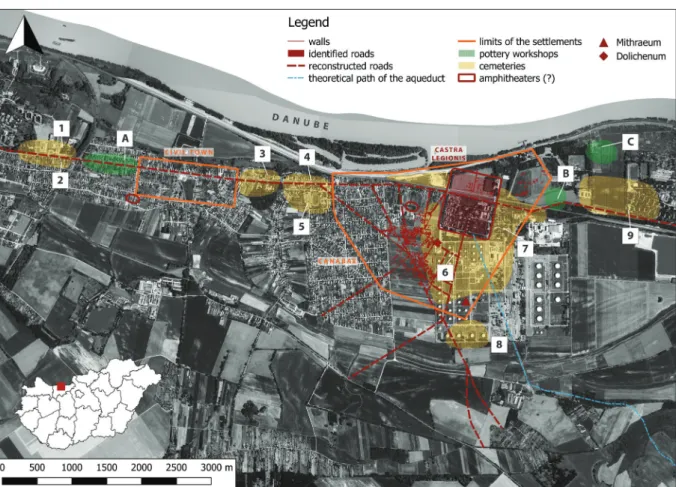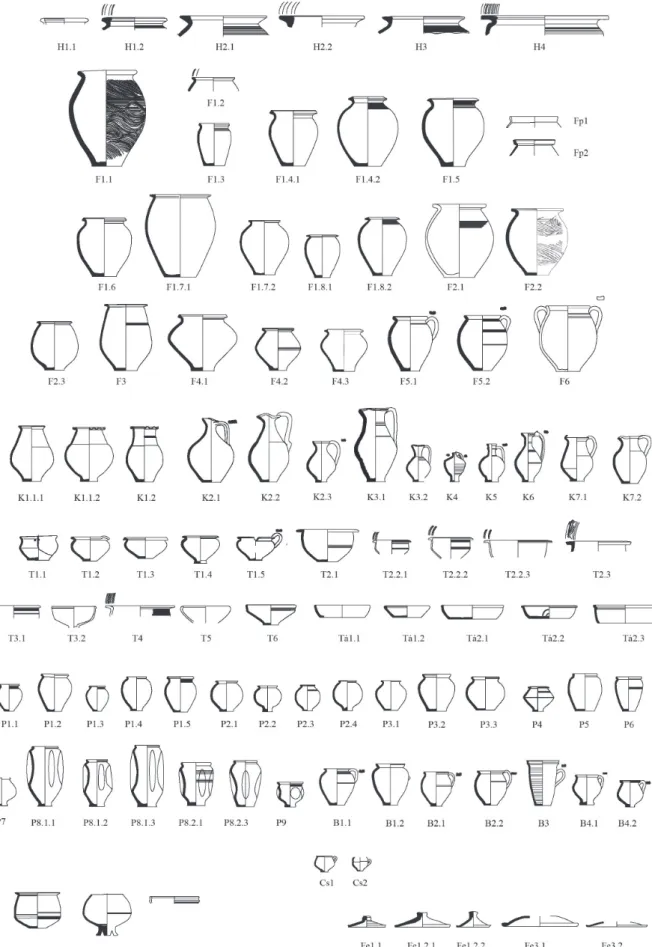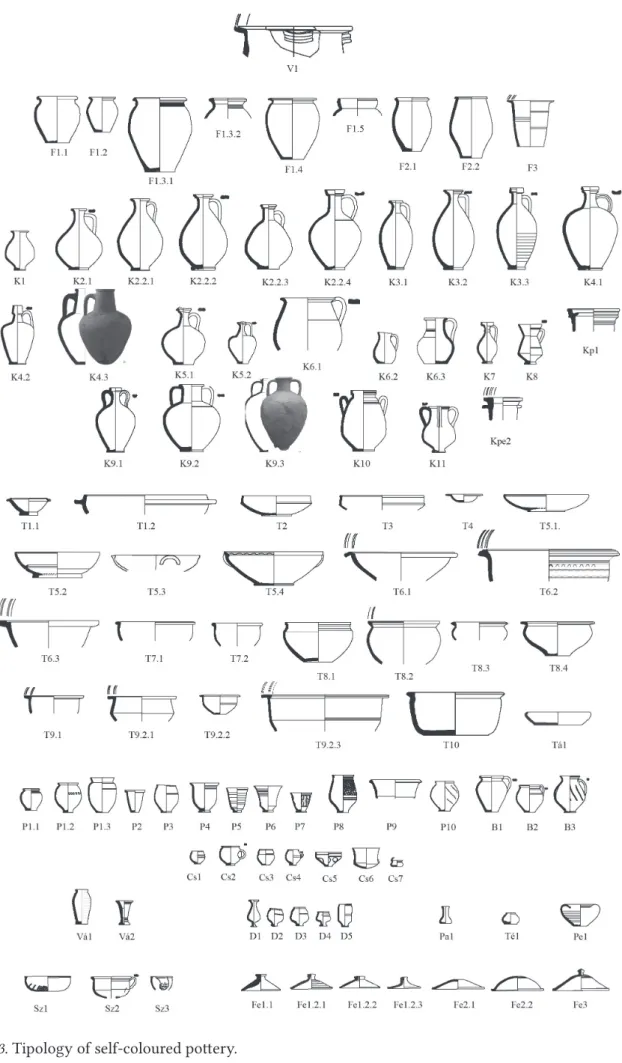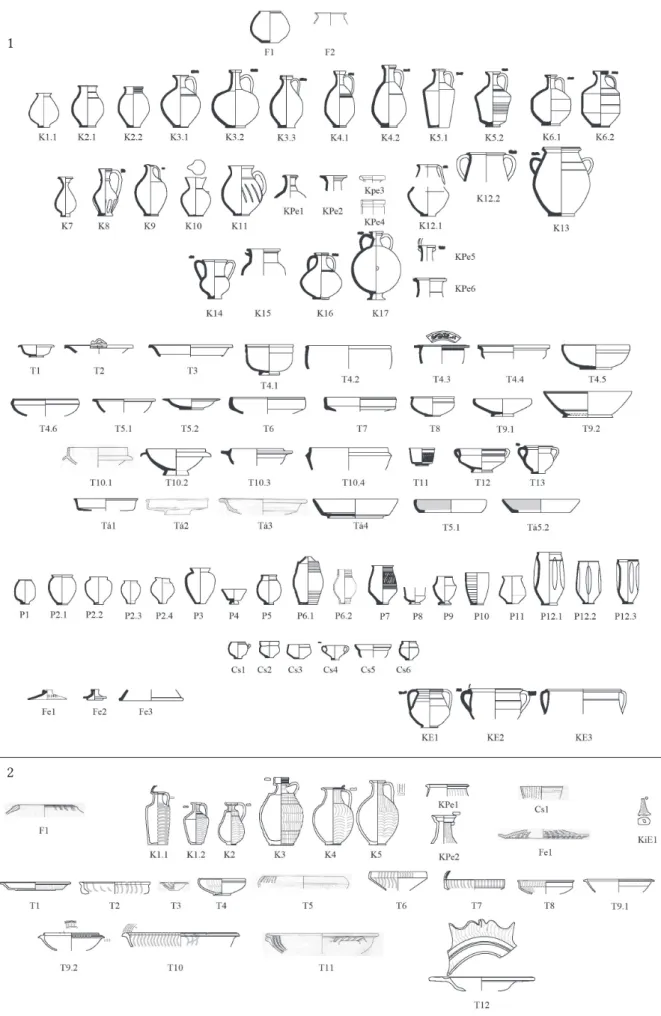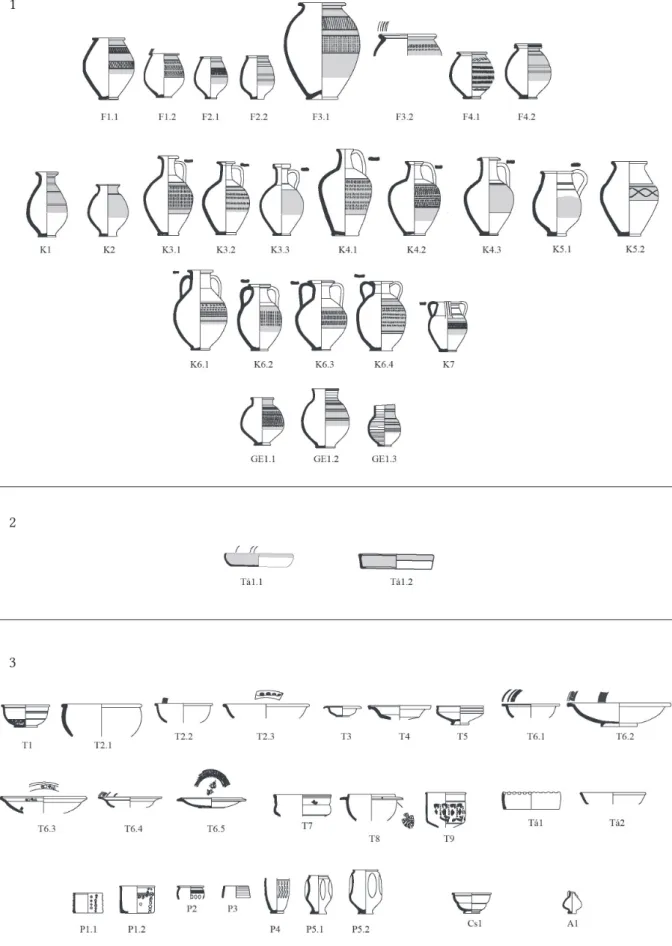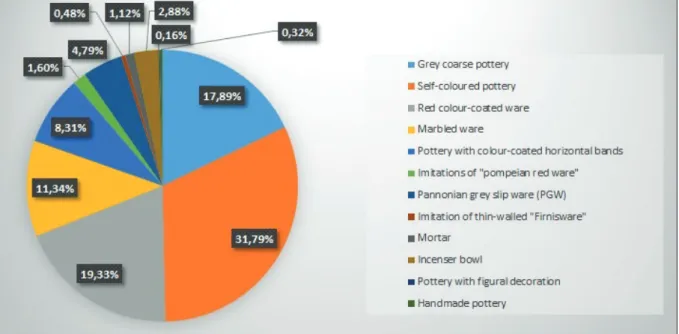Dissertationes Archaeologicae
ex Instituto Archaeologico
Universitatis de Rolando Eötvös nominatae Ser. 3. No. 8.
Budapest 2020
Dissertationes Archaeologicae ex Instituto Archaeologico Universitatis de Rolando Eötvös nominatae
Ser. 3. No. 8.
Editor-in-chief:
Dávid Bartus Editorial board:
László Bartosiewicz László Borhy Zoltán Czajlik
István Feld Gábor Kalla
Pál Raczky Miklós Szabó Tivadar Vida
Technical editor:
Gábor Váczi Proofreading:
Szilvia Bartus-Szöllősi Zsófia Kondé Márton Szilágyi
Aviable online at http://ojs.elte.hu/dissarch Contact: dissarch@btk.elte.hu
ISSN 2064-4574
© ELTE Eötvös Loránd University, Institute of Archaeological Sciences Layout and cover design: Gábor Váczi
Budapest 2020
Contents
Articles
Maciej Wawrzczak – Zuzana Kasenčáková 5
Stará Ľubovňa – Lesopark. Late Palaeolithic site and the problems associated with raw material mining
Attila Péntek – Norbert Faragó 21
Chipped stone assemblages from Schleswig-Holstein (North Germany) in the collection of the Institute of Archaeological Sciences – ELTE Eötvös Loránd University
Bence Soós 49
Middle Iron Age Cemetery from Alsónyék, Hungary
Tamás Szeniczey – Tamás Hajdu 107
Appendix – Results of the analysis of the Early Iron Age human remains unearthed at Alsónyék, Hungary
Lajos Juhász – József Géza Kiss 111
Bound in bronze – a Roman bronze statuette of a barbarian prisoner
Csilla Sáró 117
The fibula production of Brigetio: clay moulds
Field Reports
András Füzesi – Knut Rassmann – Eszter Bánffy – Hajo Hoehler-Brockmann – Gábor Kalla – Nóra Szabó – Márton Szilágyi – Pál Raczky 141 Test excavation of the “pseudo-ditch” system of the Late Neolithic settlement complex
at Öcsöd-Kováshalom on the Great Hungarian Plain
Gábor Váczi – László Rupnik – Zoltán Czajlik – Gábor Mesterházy –
Bettina Bittner – Kristóf Fülöp – Denisa M. Lönhardt – Nóra Szabó 165 The results of a non-destructive site exploration and a rescue excavation at the site
of Pusztaszabolcs-Dohányos völgy északi part
Dávid Bartus – László Borhy – Szilvia Joháczi – Emese Számadó 181 Excavations in the legionary fortress of Brigetio in 2019
Dávid Bartus – László Borhy – Emese Számadó – Lajos Juhász – Bence Simon –
Ferenc Barna – Anita Benes – Szilvia Joháczi – Rita Olasz – Melinda Szabó 189 Excavations in Brigetio in 2020
Thesis Abstracts
Anett Osztás 205
The settlement history of Alsónyék–Bátaszék.
Complex analysis of its buildings in the context of the Lengyel culture
Csilla Száraz 229
The region of the Zala and Mura Rivers (Zala County) in the Late Bronze Age.
Late Tumulus and Urnfield period
Ágnes Király 239
Human remains unearthed in settlement context from the Late Bronze Age – Early Iron Age (Reinecke BD–HaB3) Northeastern Hungary
Gergely Bóka 243
Transformation of settlement history in the Körös Region in the period between the Late Bronze Age and the end of Iron Age
Gabriella G. Delbó 263
Pottery production of the settlement complex of Brigetio
Adrienn Katalin Blay 281
Die Beziehungen zwischen dem Karpatenbecken und dem Mediterraneum von der II. Hälfte des 6. bis zum 8. Jahrhundert n. Chr. anhand Schmuckstücken und Kleidungszubehör
Levente Samu 293
Die mediterranen Kontakte des Karpatenbeckens in der Früh- und Mittel- awarenzeit im Licht der Männerkleidung. Gürtelschnallen und Gürtelgarnituren
Reviews
Gábor Mesterházy 299
Czajlik, Z. – Črešnar, M. – Doneus, M. – Fera, M. – Hellmith Kramberger, A. – Mele, M. (eds): Researching Archaelogical Landscapes Across Borders – Strategies, Methods and Decisions for the 21th Century. Graz–Budapest, 2019.
DissArch Ser. 3. No. 8. (2020) 263–279. 10.17204/dissarch.2020.263
Pottery production of the settlement complex of Brigetio
Gabriella G. Delbó
Komáromi Klapka György Museum Komárom delbogabi.kgym@gmail.com
Abstract
Abstract of PhD thesis submitted in 2020 to the Archaeology Doctoral Programme, Doctoral School of History, Eötvös Loránd University, Budapest under the supervision of László Borhy.
The aim of the dissertation
The dissertation discusses the pottery production of the settlement complex of Brigetio. The full typological and chronological overview of provincial pottery types comprises the core of the study, through the evaluation of pottery material from the civil town, partially from the legionary fortress and the military town, as well as ceramic vessels found as grave goods in the cemeteries. The role of the pottery workshops established on military territory at Gerhát and Kurucdomb in the pottery supply of various settlement units is also thoroughly examined.
The survey covers the full duration of the existence of the settlement, therefore it includes the evaluation of pottery types of both the early and the late Roman periods.
Pottery types discussed in the dissertation are as follows: 1. Grey coarse pottery, 2. Self-colour- ed pottery, 3. Red colour-coated ware, 4. Marbled ware, 5. Pottery with colour-coated horizontal bands, 6. Imitations of so-called ‘pompeian red ware’, 7. Pannonian grey slip ware, 8. Imitations of relief terra sigillata vessels, 9. ‘Firnisware’: a. Thin walled beakers (rough cast and folded beakers), b. Other rough beakers, cups and jugs, c. Imitations of black slipped ware, d. Other black slipped beakers, jugs and bowls, 10. Pottery with figural decoration: face pots, head pots, 11. Glazed pottery, 12. Burnished ware, 13. Mortar, 14. Incenser bowl, 15. Handmade pottery.
The research of pottery production in Brigetio has a long history, however the only study summarizing the topic was written by K. Póczy more than 70 years ago.1 Unfortunately her doctoral thesis from 1947 entitled Brigetio kerámiája (The pottery of Brigetio) has never been published, also its plates were lost during the following decades, thus the interpretation of the text of the manuscript became impossible. In the 1970s É. Bónis conducted the survey of various ceramic assemblages,2 the ceramic material of the pottery workshops among them, however a full publication of the Gerhát pottery workshop has never been completed. Research of local pottery received almost no attention in the 1980s; the topic came somewhat to the fore again with the evaluation of archaeological material unearthed at the Brigeto-Szőny-Vásártér exca- vations from 1992 onwards.3 Although a few pieces belonging to one of the above-mentioned
1 Póczy 1947.
2 B. Bónis 1970; B. Bónis 1975; B. Bónis 1976; B. Bónis 1977; B. Bónis 1979.
3 Bartus et al. 2012; Bartus et al. 2013; Bartus et al. 2014; Bartus et al. 2015; Bartus et al. 2016; Bartus et al. 2017.
264
Gabriella G. Delbó
pottery types were published individually, such as local imitations of imported pottery or ves- sels resembling metal or glass prototypess, these were not examined in their original context.4
The structure and methodology of the dissertation
In the first chapter of the dissertation entitled “Introduction”, I describe the aims of the study as well as the methods used. In the “Methodology” section I explain the principles of material collection and the steps of processing pottery material.
In the framework of the dissertation, the ceramic find material of the following settlement and cemetery units was processed: the civil town, the military town, the legionary fortress, cemeteries I, II and III belonging to the municipium, cemeteries of canabae – so-called Járó- ka, Sörházkert, Gerhát, Caecilia cemetery –, the late Roman Mercator and Cellás cemeteries (graveyard I-IV excavated by I. Paulovics I., the late Roman grave groups of L. Barkóczi from 1957/1959), and the so-called Gerhát and Kurucdomb pottery workshops (Fig. 1). The catalogue mainly includes the pottery material recovered from the cemeteries, the pottery workshops and the 1942 excavation campaign in the legionary fortress, as well as stray finds and the ceramic finds from the collections of the Hungarian National Museum and the Kuny Domokos Museum in Tata. The catalogue altogether contains 1252 entities, the related illustrations are presented on Plates. The already processed find material from the 1992–1996 excavation campaings of the civil town is depicted in Type Plates, the detailed typological evaluation of the individual pottery fragments was added to the dissertation as Appendix. This latter comprises 913 entities.
The terminology used in the descriptions is presented in the ‚Methodology’ chapter.
The second chapter includes the summary of research history, the first part focusing on the site itself, while the second part features the pottery research of Brigetio from the 1930s up to the present day.
The third chapter introduces the ceramic find material processed in the framework of the dissertation.
The fourth chapter is the most important section of the study, as it includes the typology itself.
Here, the processed ceramic finds are presented categorized according to individual pottery material types and formal sub-types. I surveyed the ceramic find material in detail both in a local context and the context of Pannonia and the Roman Empire.
The fith chapter includes the evaluation of the ceramic find material divided into three main chronological units, which however do not correlate with the classic division of early, middle and late Roman periods. The basis of my chronological division was the duration of exist- ence of the military pottery workshops, especially the Gerhát pottery workshop producing kitchenware (the Kurucdomb pottery workshop: from Trajan’s rule until the Marcomannic Wars, the heydays of production during the rule of the Antonine dynasty; the Gerhát pottery workshop: from Hadrian’s rule until 230). According to this division, the first chronological unit embraces the period from the Roman settlement in the area to the establishment of the pottery workshops (under the Flavian dynasty and the early Antonine dynasty). The second chronological unit includes the period during which the pottery workshops functioned (under
4 Fényes 2003a; Fényes 2003b; Fényes 2003c; Fényes 2003d; Fényes 2004.
265 Pottery production of the settlement complex of Brigetio
the Antonine and Severan dynasties), and the third chronological unit, already belonging to the late Roman age, is the period following the abandonment of the pottery workshops (from the 2nd half of the 3rd century to the end of the 4th century AD).
In my dissertation I surveyed the origins and spread of certain ceramic forms as well as the use of various decoration techniques. I also examined the available data on pottery trade within the province of Pannonia. The production programme of the Gerhát pottery workshop and the problematics of the civil town’s pottery workshop are also discussed in this chapter.
The sixth chapter includes a summary on the pottery use of the settlement and cemetery units and the relation between these.
The last part of the dissertation comprises the bibliography, the Appendix including the pot- tery typology of the 1992–1999 excavation campaigns at the Szőny-Vásártér site, the catalogue, and finally figures and plates with the drawings of ceramic finds described in the catalogue.
The results of the dissertation
Below I summarize the results achieved through the evaluation, typological classification, as well as the spatial and chronological spread analysis of the almost two thousand items pro- cessed in the framework of the dissertation.
Fig. 1. Map of Brigetio (by László Rupnik). 1 – Cemetery III of municipium, 2 – cemetery II of mu- nicipium, 3 – cemetery I of municipium, 4 – Sörházkert cemetery, 5 – Járóka cemetery, 6 – Mercator cemetery, 7 – Cellás cemetery, 8 – Caecilia cemetery, 9 – Gerhát cemetery, A – Pottery workshop of municpium, B – Gerhát pottery workshop, C – pottery workshop at Kurucdomb.
266
Gabriella G. Delbó
From the era of the Flavian dynasty and the early Antonine dynasty, that is, the period be- tween the Roman conquest and the establishment of the military pottery workshops, the data available on pottery use is so scarce that it only allows us to draw the most general con- clusions. The 1st century AD ditch system crossing cemetery III of the civil town as well as the early burials of the cemeteries which are dated by the coins of Domitian and Nerva, yielded common types of grey coarse pottery and self-coloured pottery otherwise frequent in graves. No closed layer from the end of the 1st century AD could be documented at the Szőny- Vásártér site located in the territory of the civil town, which belonged to my research area.
The earliest layer dated between 80–120 yielded grey pots, self-coloured jugs, marbled pots as well as semispherical bowls.
Pottery types and forms show a rich and diversified picture during the Antonine and Severan dynasties. This period correlates with the existence of the Kurucdomb and Gerhát pottery workshops and the graveyards established along the limes road which were mainly used up to the 3rd century AD. The era saw the evolving of the civil and military towns which thrived in the Severan booming years ater the devastation of the Marcomannic Wars, and were aban- doned by the end of the century following the Barbaric offensives in the middle of the 3rd century AD.
The dominance of grey coarse ware and self-coloured ware in the pottery material is not sur- prising as these were commonly used for cooking, baking and storing as well as tableware. In the 2nd century AD both pottery types were characterised by a variety of forms produced and used parallelly. Later, in the first half of the 3rd century the number of different ceramic types dropped and pottery use shows a considerably more uniform picture in both the settlements and the cemeteries. Among the grey coarse ware pots, bowls, plates and lids are characteristic, beakers occur almost only in graves. The majority of these types were produced at the Gerhát pottery workshop. Three-legged vessels are exceptionally rare and can be dated to the second half of the 2nd century. Although examples of the combed decoration of Celtic origin can still be observed on pottery in the second half of the 2ndcentury, the majority of the vessels were decorated with incised vertical, wavy grooves on the rim, neck or shoulder, more characteris- tic to Roman pottery tradition (Fig. 2).
In this period, beside the characteristic types of self-coloured pottery including jugs, plates, beakers and mugs, rare forms such as situlae, coin-boxes, phiolae, jars, beakers with oblique cannelure on the belly, the so-called Germanic beaker type of imported Raetian ware as well as the wash-bowls with wide, vertical handles also occur (Fig. 3).
The proportion of painted or red colour-coated pottery is much lower in the ceramic material.
Characteristic forms of red colour-coated pottery were jugs, bowls and beakers the form of which show strong influences of imported ceramics (thin-walled cups from northern Italy, terra sigillata, thin-walled ‘Firnisware’ beakers, Raetian pottery). Cups and lids are rare. Red colour-coated ware is more characteristic in the 2nd century AD but was suppressed by the beginning of the 3rd century, ater the Marcomannic Wars, and only appears again is small numbers in late Roman cemeteries (Fig. 4.1).
Marbled ware, also produced at the Gerhát and Kurucdomb pottery workshops, was common- ly used in the 2nd century AD. Beside jugs and bowls which oten resemble terra sigillata, metal or glass vessels, a few pots, cups and lids also occur. In most cases the marbled decora-
267 Pottery production of the settlement complex of Brigetio
Fig. 2. Tipology of grey coarse pottery.
268
Gabriella G. Delbó
Fig. 3. Tipology of self-coloured pottery.
269 Pottery production of the settlement complex of Brigetio
Fig. 4. 1 – Tipology of red colour-coated pottery, 2 – Tipology of marbled ware.
1
2
270
Gabriella G. Delbó
tion was applied directly onto the surface of the vessel, while in some rare instances a clear coating was added between the surface and the painted layer (Fig. 4.2).
In the second half of the 2nd century AD the Gerhát pottery workshop was one of the most important production hubs of pottery with colour-coated horizontal bands. Pots, jugs, three-handled vessels as well as vessels with roundish belly and cylindrical neck occur in the cemeteries and the civil town until the second half/third quarter of the 3rd century AD. De- pending on the form, the painted decoration was done in the same fashion: in case of jugs and three-handled vessels, the red / brownish red coating was applied on the middle of the belly, while in case of the other vessel forms the upper two-third of the body was painted. There are some decorational tendencies to be observed on the vessels, therefore it it possible to identify items belonging to the same production series (Fig. 5.1).
The painted imitations of so-called pompeian red ware only occur in this period. They were common mainly in the archaeological material of the civil town and evidence shows that the type was produced at the Gerhát pottery workshop also (Fig. 5.2).
Grey and red colour versions of Pannonian grey slip ware, either with stamped patterns or without decoration, were characteristic from the middle of the 2nd century AD and are among the types produced at the Gerhát pottery workshop. Beakers should be highlighted as they are not only rare in Pannonian context but were totally unknown from Brigetio up to this day.
Special attention should be paid to the steep-walled beakers decorated with barbotine, as they seem to cluster in the area. The forms of Pannonian grey slip ware as well as certain stamped motifs follow Italian and Gaulish terra sigillata prototypes. Vessels produced at the Gerhát pottery workshop were also found at Tokod and several fragments suggest regional trade with Aquincum and western Pannonian workshops (Fig. 5.3).
Imitations of relief terra sigillata follow southern and middle Gaulish as well as Rheinzabern patterns. These vessels were produced during the reign of Hadrian up to the beginning of the Antonine dynasty. The fragments found at Brigetio show strong connections partly withs the so-called Kiscelli pottery workshop of Aquincum as well as the so-called Gázgyár pottery workshop but partly also with relief terra sigillata imitations from Tokod, Esztergom and Bény.
Part of the thin-walled beakers (rough cast and folded beakers) are imitations of the so-called
‘Firnisware’. These pieces are eggshaped or Faltenbecher-type beakers with smooth or grainy surface, characteristic of the 2nd and beginning of the 3rd century AD. A considerable amount of beakers, mugs and one-handled jugs from the 2nd century AD with the same surface treat- ment are present in the examined pottery material, several of them are decorated with canne- lures (Fig. 6.1.2).
Imitations of black slip ware belonging to the Niederbieber 33a and 33c types appear in the archaeological material of both the civil town and the cemeteries in the first half of the 3rd century AD. Based on the materials testing carried out by E. Harsányi, these pieces were produced in the pottery workshops of Intercisa and Aquincum. Further beakers and a small aryballos-type vessel also belongs to the same period, however the black slip of these artefacts represents a different quality (Fig. 6.1.1).
The pottery workshops at Brigetio also produced grey and self-coloured versions of figural pottery (face pots and head pots). Based on their western analogues the red slip beakers can be dated to the end of the 2ndcentury – beginning of the 3rd century AD.
271 Pottery production of the settlement complex of Brigetio
Fig. 5. 1 –Tipology of potteries with colour-coated horizontal bands, 2 – Tipology of imitations of so- called „pompeian red ware”, 3 – Tipology of pannonian grey slip ware (PGW).
1
2
3
272
Gabriella G. Delbó
Fig. 6. 1 – Tipology of „Firnisware” – 1.1 – imitations of black slipped ware, 1.2 – Thin walled pottery with or without rough cast, 2 – Tipology of glazed pottery, 3 – Tipology of handmade pottery.
1
2
3
1
2
273 Pottery production of the settlement complex of Brigetio
A flat bowl belonging to the early types of glazed ware was found among the workshop waste of the Gerhát pottery workshop. A handle of a casserole with the depiction of Bacchus came to light in cemetery III of the civil town, while its clay negative was found in the civil town itself.
Both these items can be dated to the second half of the 2nd century AD (Fig. 6.2).
As for mortaria, the self-coloured, red colour-coated and striped rim versions were character- stic during the reign of the Antonine and Severan dynasties. All three versions were produced at the Gerhát pottery workshop. The stamp of Fortis can be observed on two rim fragments known as stray finds, while another fragment with a floral pattern (tendril?) came to light from the Antonine-Severan age layer of the filling of the so-called Cellar no. 1 in the civil town.5 An analogue of this latter piece is known from Raetia (Fig. 7.2).
Self-coloured as well as grey incenser bowls were both produced at the Gerhát pottery work- shop, and appear frequently in the Antonine-Severan period archaeological material of the civil town and cemeteries (Fig. 7.1).
Beside wheel-thrown ceramics, handmade pottery is also present among the finds, although in very low numbers. Typical forms are the pots, mugs, lids and cups, usually with combed dec- oration as well as a finger-impressed patterns, incised linear decoration and sculptural knobs.
These vessels were mainly used in the 2nd century AD, but in the archaeological material of the civil town they can be traced up to the first third of the 3rd century (Fig. 6.3).
In summary, it can be stated that the pottery material of Brigetio shows the largest variety of types and forms during the Antonine and Severan era. Celtic influence can barely be docu- mented, beside the tradition of combed decoration and stamped patterns it is only the pottery with colour-coated horizontal bands, a type originating from southern Pannonia, which shows La Tène traits. Strong influences of imported pottery types as well as metal and glass vessels
5 Hajdu 2013, 21, Kat. 576, VII. t./108.
1
2
3
Fig.7. 1 – Tipology of incenser bowls, 2 – Tipology of mortaria, 3 – Tipology of burnished ware.
274
Gabriella G. Delbó
can however be observed in the forms of locally produced pottery. Numerous types were among those produced at the Gerhát pottery workshop. The find assemblage related to a pot- tery storage of the Kurucdomb pottery workshop, which can be dated to the second half of the 2nd century AD, mainly included flawed self-coloured vessels such as a jug, bowls and plates.
The above-mentioned period, as already stated in my summary on typology, is strongly in- terconnected with the existence of the Gerhát pottery workshop. Already É. Bónis suggested that the Kurucdomb pottery workshop mainly producing ornamental vessels and the Gerhát pottery workshop specialised in kitchenware may be interpreted as different branches of the same workshop which broadened its offer continuously.6
Most of the archaeological material from the Gerhát pottery workshop, more important from my dissertation’s point of view, consists of workshop waste which came to light rather from the levelling layer instead of the filling of the actual pottery kilns. Therefore, in itself it does not provide much information regarding the inner chronology of the workshop. The catalogue of the dissertation includes 293 fragments, representing the full variety of the pottery mate- rial (Fig. 8). Based on the typological evaluation, red colour-coated ware, Pannonian grey slip ware as well as marbled ware belonged to the earlier, Antonine period of the workshop. Many overlaps can be documented between the forms and rim types of self-coloured and painted pottery, therefore it is certain that the same vessel forms were produced both without any painting or decorated with horizontal bands as well as in red painted or marbled versions.
Large sized jugs and ribbed bowls with bevelled walls represent peculiar types in the pottery material, which have not yet been found in either the civil town or the cemeteries. Products of the local workshops are not only known from Britetio itself but also in the neighbouring vicus of Almásfüzitő and at Ács-Vaspuszta.
Late Roman pottery is to be found in the legionary fortress as well as the late Roman ceme- teries and grave groups of Brigetio. Not only the number of pottery types but also the variety of forms fell back considerably by this period, although the era saw the rise of glazed ware.
6 Bónis 1979, 149.
Fig. 8. The types of pottery of the Gerhát pottery workshop (percentage, 626 p.).
275 Pottery production of the settlement complex of Brigetio
As for pottery types, a standardisation can be documented: the same forms of jugs, bowls, plates and cups appear among the grey coarse pottery, the red colour-coated ware as well as the glazed ware. Lead pottery forms of the late Roman period, oten resembling glass and metal prototypes, were the jugs with a flaring rim and a vertical rib on the neck as well as jugs with a collared rim and bowls with inverted rim.
Jugs, mugs, beakers and plates were produced from the typical coarse, grainy ceramic material characteristic of grey coarse ware (Fig. 2). Only a small number of red colour-coated ware is known from late Roman graves such as a bowl with ring bottom, a ceramic imitation of a cy- lindrical glass beaker, a two-handled bowl and a flask (Fig. 4.1). This latter piece represents a rare form, its analogues are known in glazed version. Glazed ware includes various pots, jugs, bowls, plates, cups, beakers and mortars. Vessels defined as candle holders are rare and can be dated to the second half of the 4th century AD. In several cases, an engobe was applied on the surface of the vessel beneath the glazing (Fig. 6.2). Only four examples of burnished ware char- acteristic of the late Roman period were found in the surveyed territory (Fig. 7.3). The location of the workshop which produced the above-mentioned late Roman pottery is still unknown.
Results on the pottery use of the various settlement units and cemeteries can by summerized as follows.
My survey touched only slightly upon the archaeological material of the military town, there- fore the data gathered from here is not suitable for more detailed analysis. In the case of the legionary fortress the results have to be considered carefully as the excavation of 1942 (the material of which I examined in the framework of the dissertationI was carried out in survey ditches and without an accurate documentation. The excavation basically yielded late Roman period pottery, with a few fragments which fit the pottery types produced at the Gerhát pot- tery workshop. From the point of view of my dissertation, this excavation serves as basis for late Roman period pottery typology, however it does not provide any further data regarding the pottery use of Roman military.
Fig. 9. The local pottery in the municipium of Brigetio (Szőny-Vásártér 1992–1996) (percentage, 913 p.).
276
Gabriella G. Delbó
The pottery material of the civil town is well suited for a detailed examination (Fig. 9). Most of the fragments correspond to the products of the Gerhát pottery workshop in both form and quality. Thus, the pottery workshop belonging to the civil town certainly had an important role in the supply of the settlement itself as well as of its cemeteries. I believe however, that any attempts at defining the exact production programme of the pottery workshop are abor- tive until a certified excavation on its territory could be carried out. Unfortunately, this is not likely to happen due to the high built-up density of the area.
Cemeteries belonging to the civil town and the military town were established along the limes road as well as the road leading to Tata (Fig. 10). The similarities between the pottery material of the graveyards reflect their contemporary use well. Therefore, the differences in the pottery material of the civil cemeteries and the military cemeteries are not in the presence or absence of certain vessel types; the ‘style difference’ can rather be documented in the proportion of pottery types and various forms belonging to certain types.
Pottery forms are dominated by those suitable for containing food or drink given as grave goods: jugs, jars, bowls and beakers. The pottery material of cemeteries II and III located south and east of the road on the western side of the civil town correspond to eachother, thus it seems certain that they once belonged to the same cemetery which occupied both sides of the road, and was in continuous use between the turn of the 1st and 2nd centuries up to the middle of the 3rd century AD. Cemetery I, situated on the eastern side of the municipium, can be dated to the same period. In both cases, the majority of the burials originate from the Anto- nine-Severan era. Among grave goods, the large number of self-coloured jugs is conspicious;
most of the thin-walled beakers (rough cast and folded beakers) as well as marbled ware also came to light from these cemeteries. On the western side ot the military town, the ‘Sörházkert’
cemetery is located north of the limes road while the ‘Járóka’ cemetery occupies the southern side. These two sites did probably also belong to a single graveyard, contemporary with the Fig. 10. The local pottery in the cemeteries of Brigetio (percentage, 613 p.).
277 Pottery production of the settlement complex of Brigetio
above-mentioned cemeteries I and II. The majority of the archaeological material which came to light here belongs to the Antonine–Severan period. Characteristic pottery from the graves include hand-formed grey pots, bowls with inverted rim, beakers and red colour-coated Fal- tenbecher. The Sörházkert and Járóka cemeteries yielded the highest number of imitations of black slipped ware (beakers). A small number of stray late Roman period graves are known from the northern side of the road. The Gerhát cemetery lies on the eastern side of the military town. This graveyard was established during the reign of Hadrian, that is, some time later that the Sörházkert and Járóka cemeteries mentioned above, and was used up until the end of the reign of the Severan dynasty. Only a few examples of grey pottery are known from the graves while self-coloured bowls with inverted rim as well as red colour-coated beakers and jugs can be considered characteristic.
Based on coin finds, cemetery V (the exact location of which is uncertain) was established in the 1st century AD and used unabruptedly until the middle of the 3rd century. Following a two-decade hiatus, its use continued up to the middle of the 4th century AD. The pottery material recovered from here includes a high amount of grey pots and beakers, but only a few bowls with inverted rim. Red colour-coated beakers, jugs, two-handled vessels and pottery with colour-coated horizontal bands also occur in high numbers, while self-coloured jugs appear only scarcely. In summary, the pottery material of cemetery V shows a closer relation to the “style” of the military town’s graveyards. Therefore, in my opinion, the location of the cemetery can be assumed in the vicinity of the canabae.
Only a few graves are known from the Caecilia cemetery situated along the inner-Pannonian road leading towards Tata. Compared to the above-mentioned graveyards, the archaeologi- cal material from this site is considerably less. Based on the grave goods, the cemetery had a phase contemporary with the graveyards mentioned earlier, and was also used in the late Roman period.
Late Roman grave groups and cemeteries cluster around the legionary fortress. Among grave goods jugs and beakers are characteristic, while bowls, plates and pots are mostly known from the territory of the fortress.
Referencies
Bartus, D. – Borhy, L. – Dévai, K. – Kis, Z. – Nagy, A. – Sey, N. – Számadó, E. – Szórádi, Zs. – Vida, I.
2012: Jelentés a Komárom–Szőny, Vásártéren 2010-ben folytatott régészeti feltárások eredmé- nyeiről (Bericht über Ergebnisse der in Komárom-Szőny, Vásártér im Jahre 2011 geführten archäologischen Ausgrabungen). Komárom-Esztergom Megyei Múzeumok Közleményei 18, 7–58.
Bartus, D. – Borhy, L. – Delbó, G. – Dévai, K. – Kis, Z. – Nagy, A. –Sey, N. – Számadó, E. – Szórádi, Zs. – Vida, I. 2013: Jelentés a Komárom–Szőny, Vásártéren 2011-ben folytatott régészeti feltárások eredményeiről (Bericht über die Ergebnisse der im Jahre 2011 in Brigetio (Fo: Komárom/Szőny, Vásártér) geführten archäologischen Ausgrabungen). Kuny Domokos Múzeum Közleményei 19, 9–94.
Bartus, D. – Borhy, L. – Delbó, G. – Dévai, K. – Kis, Z. – Nagy, A. –Sey, N. – Számadó, E. – Vida, I.
2014: Jelentés a Komárom–Szőny, Vásártéren 2012-ben folytatott régészetifeltárások ered- ményeiről (Bericht über die Ergebnisse der im Jahre 2012 in Brigetio (Fo: Komárom/Szőny, Vásártér). Kuny Domokos Múzeum Közleményei 20, 33–90.
278
Gabriella G. Delbó
Bartus, D. – Borhy, L. – Delbó, G. – Dévai, K. – Kis, Z. – Nagy, A. – Sáró, Cs. – Sey, N. – Számadó, E. – Vida, I. 2015: Jelentés a Komárom–Szőny, Vásártéren 2013-ban folytatott régészeti feltárások eredményeiről (Bericht über die Ergebnisse der im Jahre 2013 in Brigetio (Fo: Komárom/Szőny, Vásártér). Kuny Domokos Múzeum Közleményei 21, 7–78.
Bartus, D. – Borhy, L. – Delbó, G. – Dévai, K. – Kis, Z. – Hajdu, B. – Nagy, A. – Sáró, Cs. – Sey, N. – Számadó, E. – Juhász, L. 2016: Jelentés a Komárom–Szőny, Vásártéren 2014-ben folytatott ré- gészeti feltárások eredményeiről (Bericht über die Ergebnisse der im Jahre 2014 in Brigetio (Fo:
Komárom/Szőny, Vásártér). Kuny Domokos Múzeum Közleményei 22, 113–191.
Bartus, D. – Borhy, L. – Delbó, G. – Dévai, K. – Kis, Z. – Hajdu, B. –Nagy, A. – Sáró, Cs. – Sey, N. – Számadó, E. – Juhász, L. 2017: Jelentés a Komárom-Szőny, Vásártéren 2015-ben folytatott régé- szeti feltárások eredményeiről (Report on the excavations in the civil town of Komárom-Szőny, Vásártér [Brigetio] in 2015). Kuny Domokos Múzeum Közleményei 23, 83–154.
B. Bónis, É. 1970: A brigetioi sávos kerámia (Die streifenverzierte Keramik aus Brigetio). Folia Archae- ologica 21, 71–86.
B. Bónis, É. 1975: A brigetioi katonaváros fazekastelepei. FoliaArchaeologica 26, 71–89.
B. Bónis, É. 1976: Edényraktár a brigetioi katonaváros fazekastelepén (Gefäßdepot im Töpferviertel der Militärstadt von Brigetio). Folia Archaeologica 27, 73–87.
B. Bónis, É. 1977: Das Töpferviertel am Kurucdomb von Brigetio. Folia Archaeologica 28, 105–142.
B. Bónis, É. 1979: Das Töpferviertel „Gerhát” von Brigetio. Folia Archaeologica 30, 99–155.
Fényes, G. 2003a: Untersuchungen zur Keramikproduktion von Brigetio. Acta Archaeologica Academiae Scientiarum Hungaricae 54, 101–163. doi: 10.1556/AArch.54.2003.1-2.4
Fényes, G. 2003b: Import kerámiák és helyi utánzataik Brigetioból (Importierte Keramik und ihre lokalen Nachahmungen in Brigetio [außer Terra Sigillaten]). Komárom-Esztergom Megyei Múzeumok Közleményei 10, 5–33.
Fényes, G. 2003c: Import kerámia Brigetióban és az importáru hatása a helyi fazekasságra. Ókortudo- mányi Értesítő 12, 14–25.
Fényes, G. 2003d: Untersuchungen zum Keramikhandel von Brigetio. Münstersche Beiträge zur Antiken Handelgeschichte 22, 85-109.
Fényes, G. 2003e: Die Auswertung des Keramikmaterials der Ausgrabung 1992–1998, Fundort: Komá- rom/Szőny-Vásártér. In: Sašel Kos, M.–Scherrer, P.–Kuntić-Makvić, B.–Borhy, L. (eds): The autonomous Town of Noricum and Pannonia. Die autonomen Städte in Noricum und Pannonia II.
Situla 41, Ljubljana.
Hajdu, B. 2013: A Szőny-Vásártéren 2009-ben feltárt római kori pince kerámiaanyaga (kivéve terra sigil- lata). BA Thesis (manuscript). Budapest.
Póczy, K. 1947: Brigetioi kerámia. PhD thesis (manuscript). Budapest.
279 Pottery production of the settlement complex of Brigetio
Tab. 1. List of abbreviations of main forms.
Abbreviation Latin/Hungarian English
A aryballos aryballos
B bögre mug
Cs csésze cup
D dugó stopper
Dt dörzstál mortar
F fazék pot
Fe fedő lid
Fpe fazék perem pot’s rim
Ft füstölőtál incenser bowl
GE gömbtestű edény vessels with roundish belly
Gy gyertyatartó candle holder
H hombár storage jar
He háromlábú edény tripod bowl
K korsó, kancsó jug, jar
KE kétfülű edény two-handled vessel
KiE kiöntős edény vessel with spout
Kpe korsó, kancsó perem jug’s rim
P pohár beaker
Pa palack phial
Pe persely coin-box
S Tn serpenyőnyél terrakotta negatívja terracotta mould of casserole’s handle
S serpenyőnyél casserole’s handle
Sz szűrő sieve
T tál bowl
Tá tányér plate
Té tégely jar
V vödör situla
Vá váza vase
